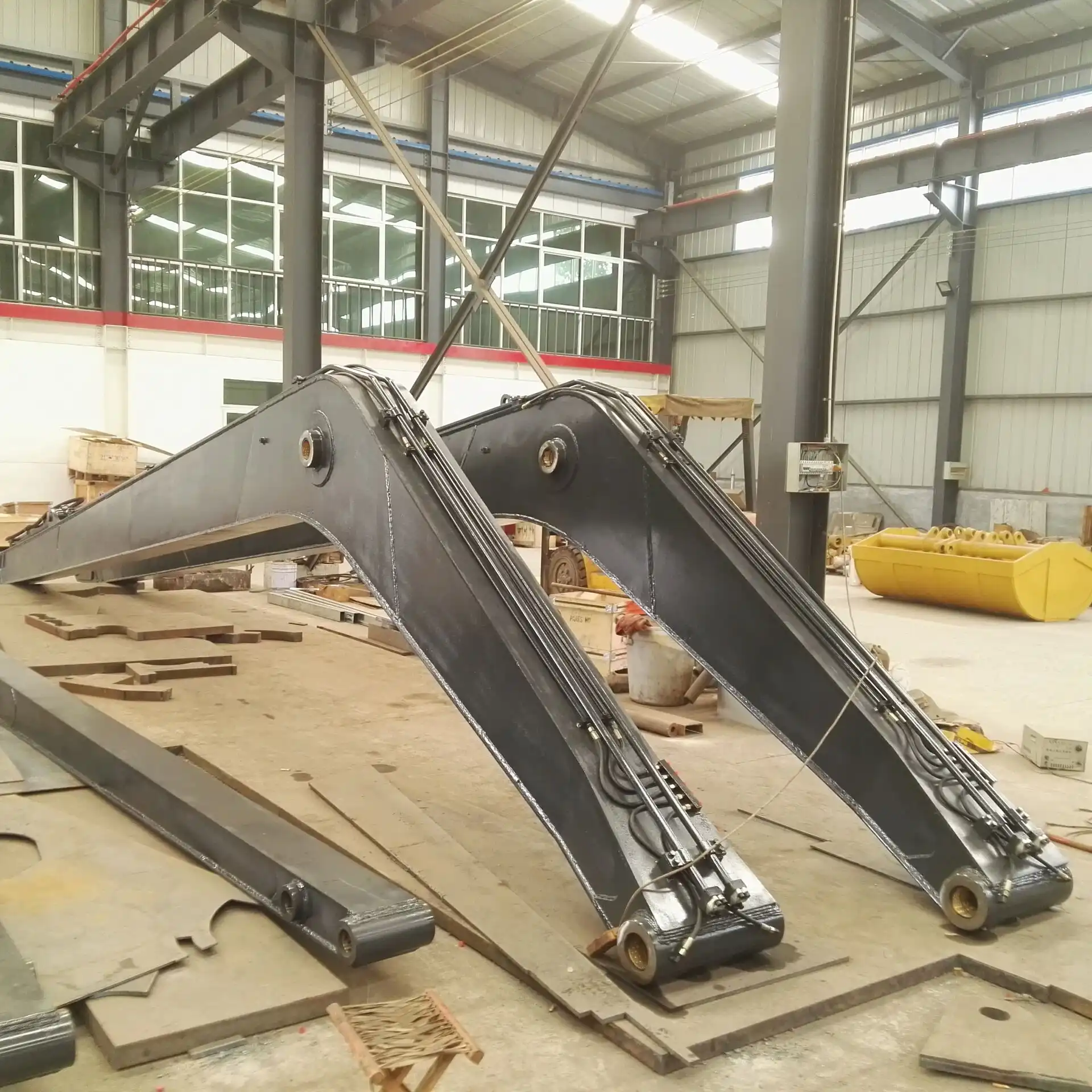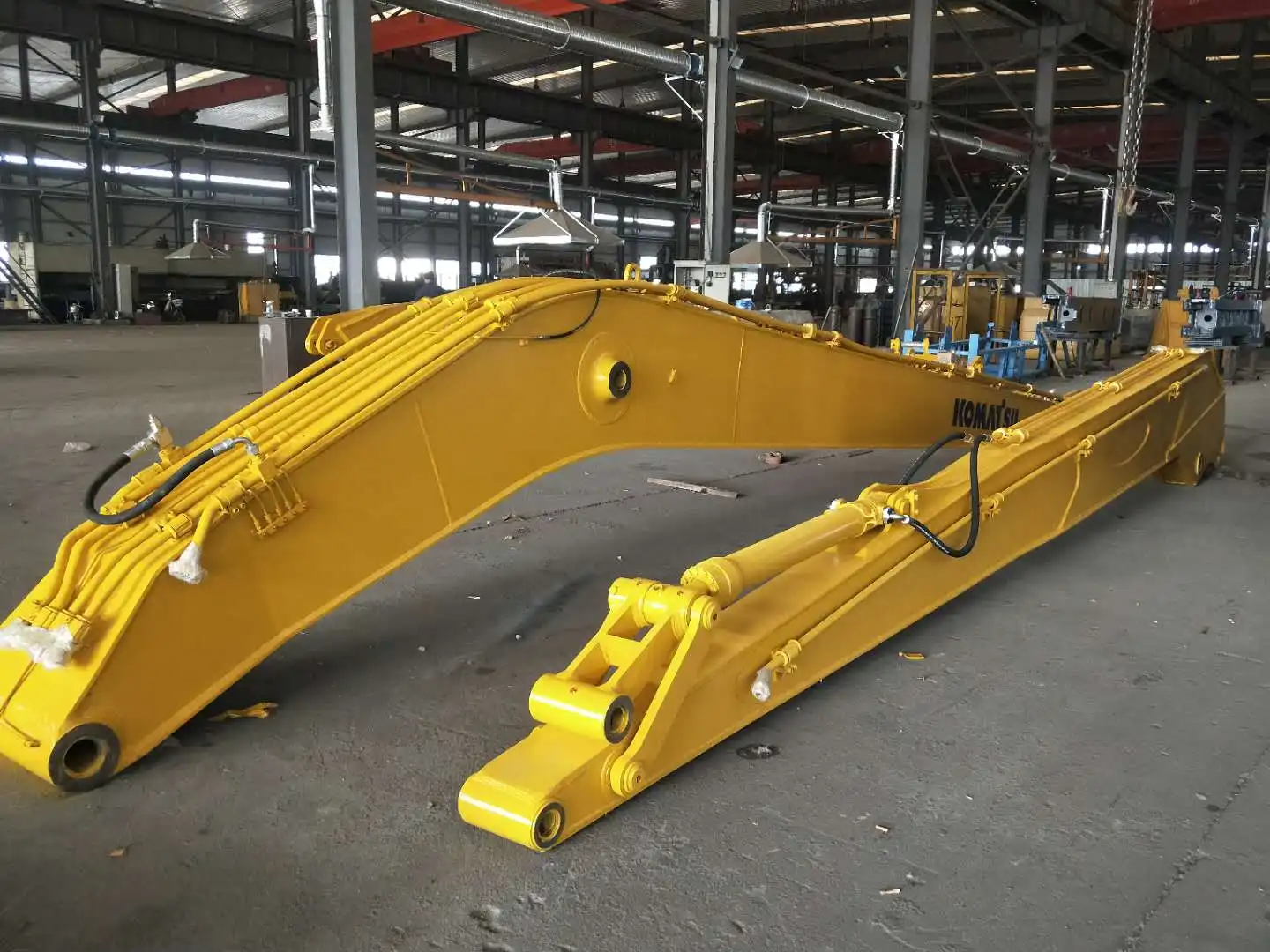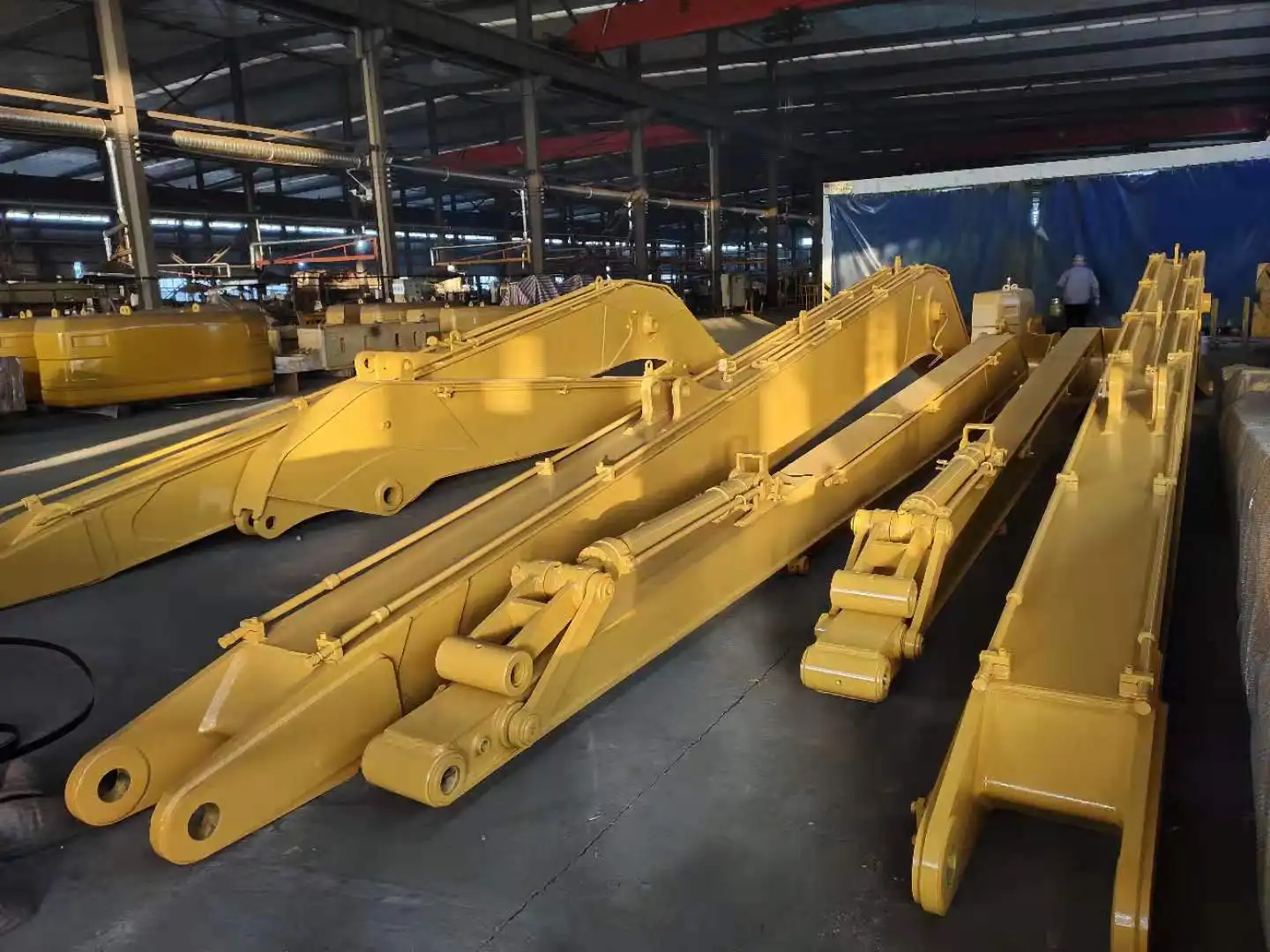What causes an excavator boom to crack?
Excavator boom cracks can significantly impact the performance and safety of heavy machinery. These structural issues often stem from a combination of factors, including long-term fatigue loading, weld quality defects, and corrosion and wear. Understanding these causes is crucial for construction companies, mining operations, and demolition industries to maintain their equipment effectively and ensure optimal performance. Let's delve into the primary reasons behind boom cracks and explore preventive measures to extend the lifespan of these essential components.
Long-Term Fatigue Loading
Overloading: The Primary Culprit for Boom Fatigue
Overloading is a significant contributor to excavator boom cracks. When operators consistently push the machine beyond its designed capacity, it places excessive stress on the boom structure. This repeated overloading can lead to metal fatigue, weakening the boom over time and eventually causing cracks to form. It's crucial for equipment managers and operators to adhere to the manufacturer's specified load limits to prevent premature wear and tear.
Repeated Stress Cycles: Cumulative Damage to Booms
Even when operating within recommended load limits, excavator booms are subject to repeated stress cycles during normal operation. Each time the boom is extended, retracted, or loaded, it experiences stress. Over thousands of cycles, this cumulative stress can lead to microscopic damage in the metal structure. These tiny imperfections can grow into larger cracks if not addressed promptly. Regular inspections and non-destructive testing can help identify early signs of fatigue damage before they escalate into more serious issues.
Improper Maintenance: Accelerating Fatigue-Induced Cracks
Neglecting proper maintenance routines can accelerate the formation of fatigue-induced cracks in excavator booms. Failing to lubricate pivot points, replace worn bushings, or address minor damages can increase stress on the boom structure. Additionally, improper adjustment of hydraulic systems can lead to uneven load distribution, further exacerbating fatigue issues. Implementing a comprehensive maintenance schedule that includes regular inspections, lubrication, and timely repairs is essential for preventing premature boom failures and ensuring the longevity of the equipment.

Weld Quality Defects
Poor Welding Techniques: Weakening Boom Structural Integrity
The quality of welding plays a crucial role in the structural integrity of excavator booms. Poor welding techniques can introduce weaknesses that become focal points for crack initiation. Inadequate penetration, lack of fusion, or excessive heat input during the welding process can create stress concentrations in the boom structure. These imperfections may not be immediately visible but can lead to catastrophic failures under load. Ensuring that all welding is performed by certified professionals using proper techniques and equipment is vital for maintaining boom integrity.
Inadequate Heat Treatment: Compromising Weld Strength
Proper heat treatment is essential for maintaining the strength and durability of welded joints in excavator booms. Inadequate or improper heat treatment can leave the welded areas vulnerable to cracking under stress. The heat-affected zone (HAZ) surrounding the weld can become brittle or overly soft, depending on the cooling rate and post-weld heat treatment. This can lead to premature failure of the boom, especially in high-stress areas. Implementing strict quality control measures and following manufacturer-recommended heat treatment procedures are crucial steps in preventing weld-related boom cracks.
Weld Porosity: Creating Stress Concentration Points
Weld porosity, characterized by small voids or gas pockets within the weld metal, can significantly compromise the strength of excavator booms. These tiny imperfections act as stress concentration points, providing ideal locations for cracks to initiate and propagate. Porosity can result from improper shielding gas coverage, contaminated base materials, or incorrect welding parameters. Regular inspection of welds using non-destructive testing methods, such as ultrasonic or radiographic testing, can help identify porosity issues before they lead to boom failure. Addressing these defects promptly through proper repair procedures is essential for maintaining the structural integrity of the excavator boom.

Corrosion And Wear
Environmental Factors: Accelerating Boom Corrosion
Environmental conditions play a significant role in the corrosion of excavator booms. Exposure to moisture, salt air in coastal regions, and chemical contaminants can accelerate the corrosion process, weakening the metal structure over time. This corrosion can create surface pits and irregularities that serve as stress concentration points, making the boom more susceptible to cracking under load. Implementing proper storage practices, using corrosion-resistant materials where possible, and applying protective coatings can help mitigate the effects of environmental corrosion on excavator booms.
Abrasive Materials: Causing Premature Wear on Booms
The handling of abrasive materials, such as sand, gravel, or rocky soil, can cause significant wear on excavator booms. This abrasive action gradually erodes the boom's surface, reducing its thickness and weakening its overall structure. As the boom material thins, it becomes more prone to cracking under normal operating stresses. Using wear-resistant materials or protective liners in high-wear areas of the boom can help extend its lifespan and reduce the likelihood of cracks developing due to material loss.
Lack of Protective Coatings: Exposing Booms to Damage
The absence or degradation of protective coatings leaves excavator booms vulnerable to various forms of damage. Without adequate protection, booms are more susceptible to corrosion, abrasion, and impact damage, all of which can contribute to crack formation. Regular inspection and maintenance of protective coatings, including prompt repair of any damaged areas, is crucial for preserving the boom's structural integrity. Applying high-quality, durable coatings that are appropriate for the operating environment can significantly extend the service life of excavator booms and reduce the risk of cracking.
Understanding the causes of excavator boom cracks is essential for maintaining the safety and efficiency of heavy machinery operations. By addressing long-term fatigue loading, ensuring weld quality, and protecting against corrosion and wear, equipment managers can significantly extend the lifespan of their excavator booms. Regular inspections, proper maintenance, and adherence to manufacturer guidelines are key to preventing costly failures and downtime. As the construction and mining industries continue to evolve, staying informed about best practices in equipment maintenance will be crucial for optimizing performance and safety in challenging work environments.

FAQ
1. How often should excavator booms be inspected for cracks?
Excavator booms should be visually inspected daily before operation and undergo thorough professional inspections at least annually or as recommended by the manufacturer. More frequent inspections may be necessary in harsh operating conditions.
2. Can small cracks in an excavator boom be repaired?
Small cracks can often be repaired through welding or reinforcement techniques. However, it's crucial to have a certified professional assess the damage and perform the repair to ensure the boom's structural integrity is fully restored.
3. What are the signs of fatigue in an excavator boom?
Signs of fatigue include visible cracks, unusual noises during operation, decreased performance, and excessive flexing of the boom. Regular non-destructive testing can also reveal early signs of fatigue before visible cracks appear.
4. How does cold weather affect excavator boom cracking?
Cold weather can make metal more brittle and prone to cracking. It's important to warm up hydraulic systems properly and avoid sudden, high-stress operations in extremely cold conditions to prevent boom damage.
5. Are certain types of excavator booms more susceptible to cracking?
While all booms can experience cracking, longer booms and those frequently used for heavy lifting or in harsh environments may be more susceptible. The design, material quality, and manufacturing process also play significant roles in a boom's resistance to cracking.
China Excavator Boom Supplier
TianNuo Machinery stands as a leading excavator boom manufacturer in China, offering a comprehensive range of high-quality excavator components and attachments. Their product line includes specialized equipment for railway maintenance, such as sleeper changing machines and ballast screening buckets. TianNuo also excels in excavator modifications, providing options like lifting cabs and extended arms to enhance machine versatility. With a focus on durability and performance, TianNuo Machinery produces various excavator accessories, including digging buckets, wood clamps, and soil rippers, catering to diverse industry needs. For those seeking reliable excavator-related equipment, you can contact us at arm@stnd-machinery.com for more information on our extensive product range and customization options.
References
- Smith, J. D., & Johnson, R. T. (2022). "Fatigue Analysis of Excavator Booms under Variable Loading Conditions." Journal of Construction Engineering and Management, 148(3), 04022001.
- Zhang, L., & Liu, X. (2021). "Weld Quality Assessment in Heavy Machinery: A Focus on Excavator Booms." International Journal of Fatigue, 150, 106290.
- Brown, M. E., & Davis, S. K. (2023). "Corrosion Mitigation Strategies for Construction Equipment in Harsh Environments." Corrosion Science, 205, 110542.
- TianNuo Machinery. (2023). "Excavator Boom Design and Manufacturing Specifications." TianNuo Machinery Official Documentation.
- Anderson, P. L., & Wilson, E. R. (2022). "Preventive Maintenance Practices for Heavy Machinery in Construction and Mining." Excavator Maintenance Handbook (3rd ed.), Chapter 7, pp. 189-215.
- Lee, H. S., & Park, C. W. (2021). "Non-Destructive Testing Methods for Crack Detection in Excavator Booms." Welding Journal, 100(9), 259s-268s.
About Author: Arm
Arm is a leading expert in the field of specialized construction and railway maintenance equipment, working at Tiannuo Company. Tiannuo specializes in manufacturing a wide range of products, including railway maintenance equipment like railway sleeper changing machines and screening machines, excavator modification equipment such as excavator lifting cabs, various engineering arms for excavators, excavator accessories like digging buckets, and engineering vehicle auxiliary equipment like loader buckets.

